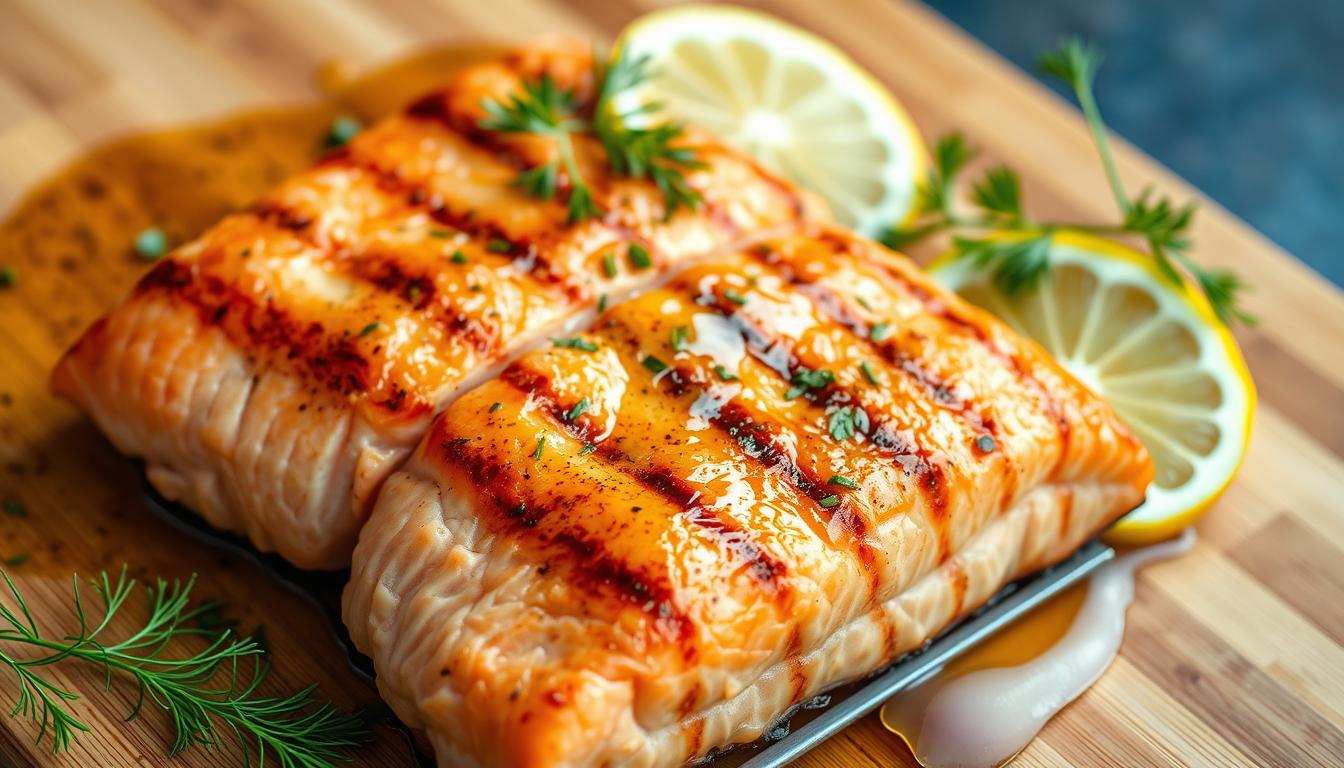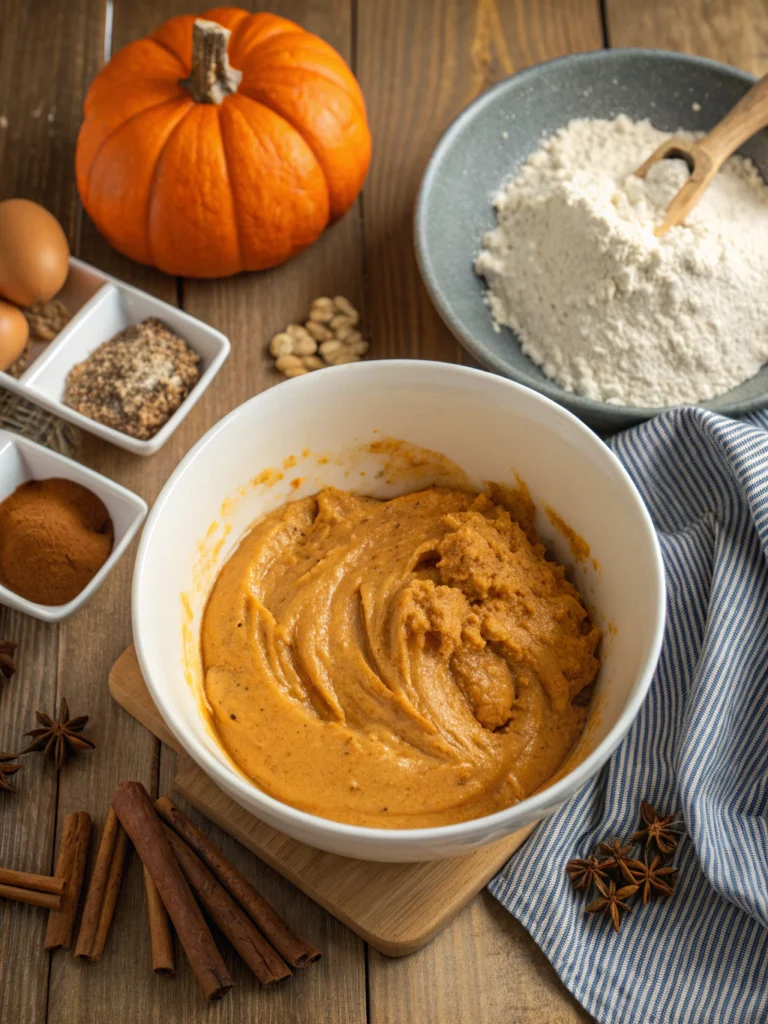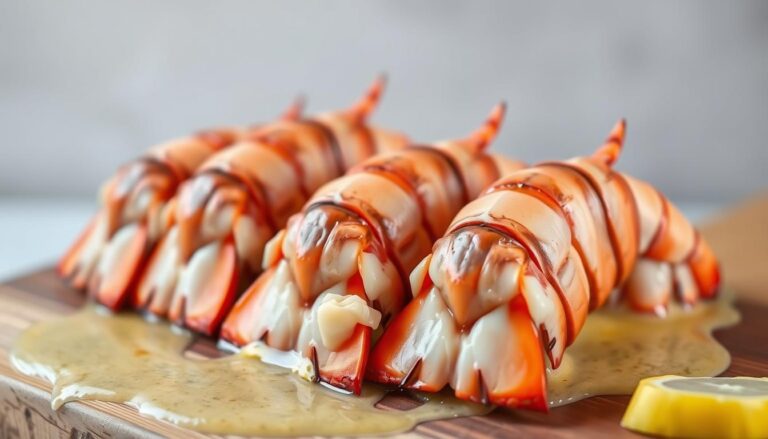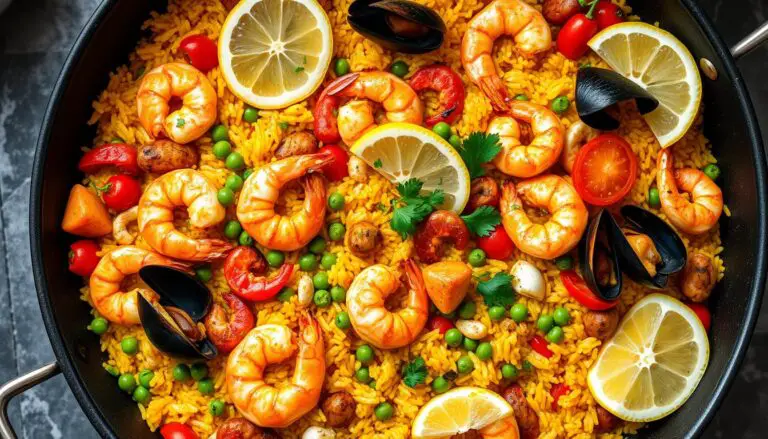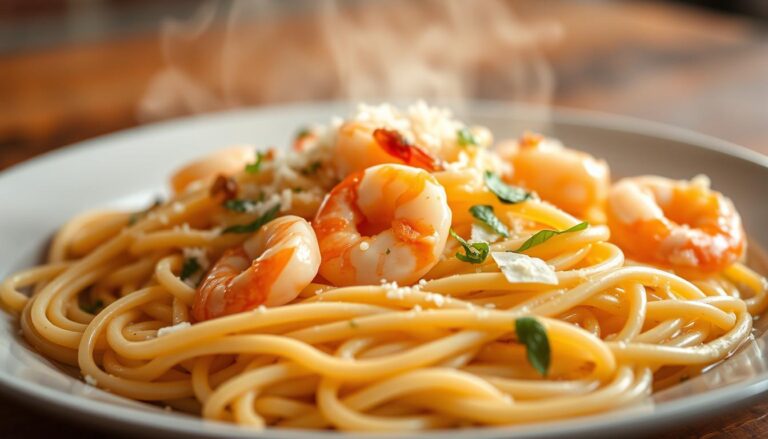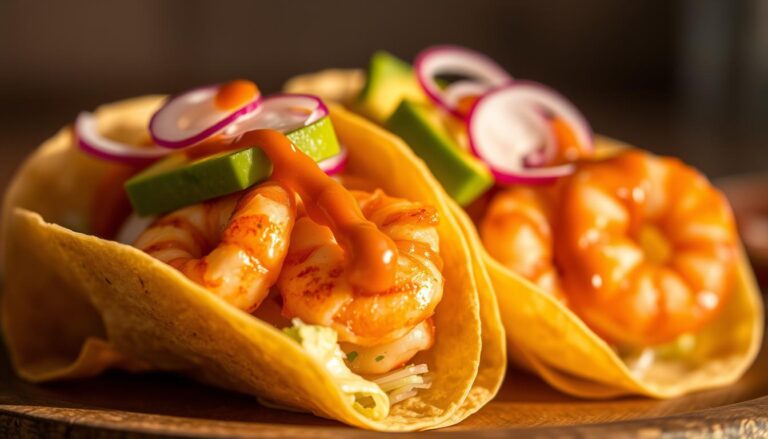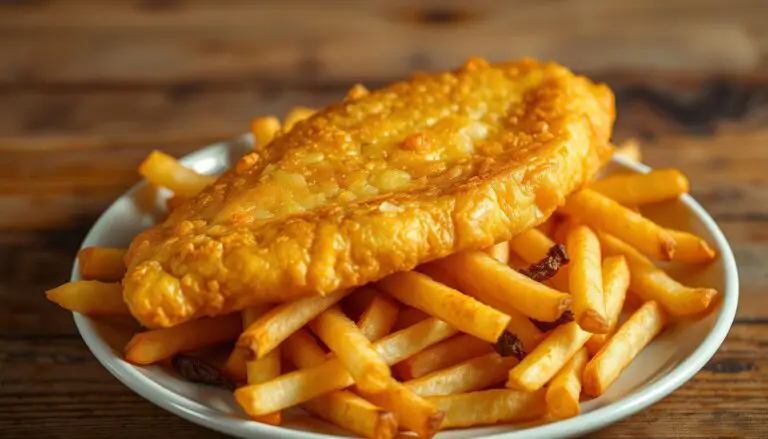There’s something special about a perfectly Grilled Salmon Recipe dinner that never fails to impress. For me, it’s all about the flavorful simplicity of a well-cooked salmon. When done right, it’s a culinary experience that’s hard to beat.
I still remember the first time I mastered the art of grilling salmon to perfection. It was a game-changer for my dinner routine. Now, I’m excited to share my favorite recipe with you, and I’m confident you’ll love it just as much as I do.
With this simple grill technique, you can create a mouth-watering dinner in under 30 minutes. The best part? It’s a healthy and satisfying meal that’s perfect for any night of the week.
Key Takeaways
- Learn how to select the best salmon for grilling
- Master the art of grilling fish to perfection
- Discover my personal tips for enhancing salmon‘s natural flavors
- Prepare a complete dinner in under 30 minutes
- Create restaurant-quality grilled salmon at home with minimal effort
Why Grilled Salmon Makes the Perfect Dinner
When it comes to a perfect dinner, grilled salmon stands out due to its exceptional flavor and health benefits. Grilled salmon is not only a treat for the taste buds, but it also offers numerous nutritional advantages.
Health Benefits of Salmon
Salmon is rich in omega-3 fatty acids, which are essential for heart health and brain function. It’s also an excellent source of protein and various vitamins and minerals.
Why Grilling Enhances Salmon’s Flavor
Grilling salmon creates a caramelized exterior while keeping the interior moist. The high heat of grilling helps develop complex flavors through the Maillard reaction, enhancing the overall taste experience.
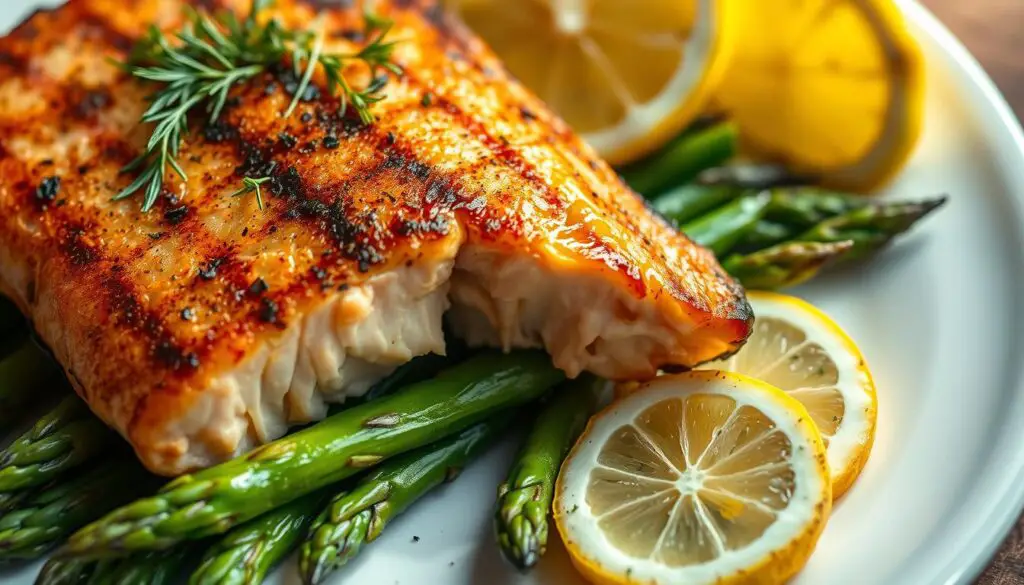
Choosing the Best Salmon for Grilling
Selecting the right salmon is the first step towards a mouth-watering grilled salmon dish. The type of salmon you choose can significantly impact the flavor and texture of your grilled fish.
Types of Salmon and Their Characteristics
There are several types of salmon, each with unique characteristics. Wild Pacific Salmon, found in the Pacific ocean, come in five main varieties. They are known for their pronounced flavor and firmer texture. Atlantic Salmon, on the other hand, is now endangered in the wild and is mostly farmed.

Wild vs. Farmed Salmon
Wild salmon typically has a more pronounced flavor and firmer texture compared to farmed salmon. Farmed salmon, particularly Atlantic Salmon, often has a higher fat content, making it more forgiving on the grill. When choosing farmed salmon, look for sustainably-farmed options raised in closed tank aquaculture or low-density net pens to minimize environmental impact.
Essential Preparation Before Grilling
Getting your salmon ready for the grill involves more than just seasoning. Proper preparation is crucial for achieving that perfect grilled salmon.
Cleaning and Portioning Your Salmon
Before grilling, it’s essential to clean and portion your salmon correctly. This involves rinsing the fish under cold water and patting it dry with paper towels. Proper cleaning and drying help ensure the salmon cooks evenly and prevents it from sticking to the grill.
Skin-On vs. Skin-Off Considerations
One important decision when preparing salmon is whether to grill it with the skin on or off. Keeping the skin on can be beneficial as it helps hold the fish together and provides a natural barrier against the heat. The salmon skin can be eaten and is particularly enjoyable when crispy. To achieve crispy skin, it’s crucial to keep the skin side dry and well-oiled. Avoid marinating the skin side as it can become soggy. Instead, lightly oil and salt the skin to get it crispy.
On the other hand, removing the skin can be preferable in certain situations, and adjusting your grilling technique accordingly is key. Understanding these considerations will help you make an informed decision based on your preferences and the specific grilling conditions.
My Favorite Grilled Salmon Recipe
One of my go-to dinner recipes is grilled salmon, which I prepare using a simple yet flavorful marinade. This dish is not only delicious but also packed with nutrients.
Ingredients You’ll Need
To make this recipe, you’ll need fresh salmon fillets, preferably with the skin on. You’ll also need ingredients for the marinade, including olive oil, lemon juice, garlic, and herbs like thyme and parsley. Don’t forget salt and pepper to season.
Step-by-Step Preparation Instructions
Start by preheating your grill to medium heat (325°F-350°F). Pat the skin side of the salmon dry and brush it with olive oil; season with salt. In a small bowl, whisk together the marinade ingredients until smooth. Brush the marinade liberally over the salmon, saving some for basting. Grease the grill well to prevent sticking. Place the salmon on the grill, cover, and check after 5 minutes. Continue cooking covered until the internal temperature reaches 125-130°F. Use 2-3 tablespoons of marinade for basting during cooking.
Mastering the Grilling Technique
The key to a mouth-watering grilled salmon lies in mastering the grilling technique. Grilling salmon is an art that requires attention to detail, the right tools, and a bit of practice.
Ideal Grill Temperature and Setup
Preheating your grill to the right temperature is crucial. For grilling salmon, a medium-high heat, around 400°F to 425°F, is ideal. Ensure your grill grates are clean and brush them with oil to prevent sticking.
How Long to Grill Salmon
Grilling time depends on the thickness of your salmon fillet. A general rule is to grill for 4-6 minutes per side for a 1-inch thick fillet. However, the internal temperature should reach 125-130°F for optimal doneness.
When and How to Flip Salmon
For cut pieces with skin, grill skin side down first for 5 minutes until the skin is crispy. Then, turn over for just a few more minutes. You don’t need to flip whole filets. Use a thin, wide spatula to flip delicate salmon fillets without breaking them.
- Start with skin-side down for crispy skin.
- Flip gently to avoid breaking the fillet.
- Cook until the internal temperature reaches 125-130°F.
Flavor Variations for Grilled Salmon
One of the joys of grilled salmon is the endless possibilities for adding flavor through marinades, rubs, and sauces. Grilled salmon can be transformed with a range of flavors, from subtle to bold, making it a versatile dish for any occasion.
Marinade Options
A good marinade can enhance the flavor of your grilled salmon. Consider using a mixture of olive oil, lemon juice, garlic, and herbs like thyme or rosemary for a classic taste. For a more exotic flavor, try combining soy sauce, maple syrup, and ginger.
Dry Rubs and Seasoning Blends
Dry rubs offer another way to add depth to your grilled salmon. A simple blend of salt, pepper, and paprika can provide a smoky flavor, while a mix of brown sugar, chili powder, and cumin can give it a spicy kick.
Sauce Pairings
When it comes to sauce, the options are vast. You can use a reserved marinade (if heated properly), or try a sauce like lemon butter, dill, or a yogurt-based sauce served on the side. These sauces can be made while the salmon is grilling, offering a fresh and complementary taste to your grilled salmon.
- Lemon butter sauce for a rich and citrusy taste
- Dill sauce for a fresh and herbaceous flavor
- Yogurt-based sauces for a cool and creamy contrast
Expert Tips for Perfect Grilled Salmon Every Time
Achieving perfectly grilled salmon is a skill that can be mastered with the right techniques and a bit of practice. To grill salmon to perfection, it’s essential to understand the common pitfalls and how to avoid them.
Avoiding Common Grilling Mistakes
One of the most common mistakes when grilling salmon is overcooking it. To avoid this, make sure to monitor the cooking time closely. It’s also crucial to preheat your grill properly and oil the grates to prevent sticking, especially if you’re grilling with the skin on.
How to Tell When Salmon is Perfectly Done
Perfectly grilled salmon should be cooked to medium, reaching an internal temperature of 125°F. You can check for doneness by using a thermometer or by peeking with a knife at the thickest part. The fish should flake easily but still retain some translucency in the center. This usually takes a few cook minutes, depending on the thickness of the fillet. When it’s done cooking, remove it from the grill promptly.
Conclusion: Enjoying Your Delicious Grilled Salmon
As we conclude our journey through the world of grilled salmon, it’s clear that this dish offers endless possibilities. Throughout this article, we’ve covered the essential techniques for grilling salmon to perfection, from choosing the right type of salmon to mastering the grill temperature.
The versatility of grilled salmon makes it suitable for both everyday meals and special occasions. I encourage you to experiment with the various marinades, rubs, and techniques shared to find your personal favorites. When serving, consider pairing your grilled salmon with complementary side dishes like roasted vegetables or quinoa salad.
Mastering grilled salmon is not just about following a recipe; it’s about unlocking a world of culinary creativity. With practice, you’ll be grilling salmon to perfection in just a few minutes. This skill can also be a gateway to exploring other grilled seafood recipes, further expanding your culinary repertoire.

